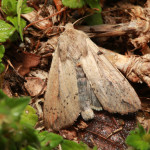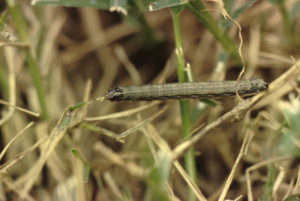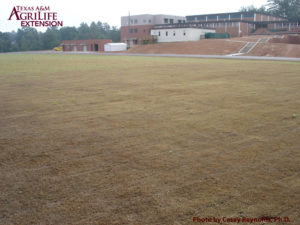
A true armyworm adult hiding in thatch layer of lawn
Be on the alert for fall armyworms this fall. Higher-than-normal populations of this lawn-eating insect have been reported from many areas in Texas this past summer and we have started to see them in San Antonio and Austin areas.
While fall armyworms are nothing new, according to Wizzie Brown, Extension Program Specialist for IPM in Austin, these worms started appearing in home lawns in late July to early August. Usually, infestations take place in late summer or early fall, but the weather can play a big part. The amount of rain we have had this year helped with egg survival and it can also delay predators from feeding on the eggs.
Fall armyworm (FAW) is the caterpillar stage of a drab gray moth, known scientifically as Spodoptera frugiperda. It feeds primarily on grasses, though it has been reported feeding on dozens of non-grass plants and weeds. It earns the name “armyworm” from its habit, during times of major outbreaks, of marching, army-like, across fields, roads, and yards, consuming everything in its path.

Fall armyworm on bermudagrass
The armyworm caterpillar is identified by three thin white or yellow stripes on the shield behind the head (pronotum), an inverted white Y on the face between the eyes, and by four dark hair-bearing bumps (tubercles) on the top of the 8th abdominal segment. It takes three to four weeks of feeding to reach its full length of about 1.25 inches (34 mm). For a video that will help you recognize this worm check out this episode of Backyard Bug Hunt.
The adult FAW moth has a wingspan of about 1.5 in. The hind wings are white; the front wings are dark gray, mottled with lighter and darker splotches. On male moths each forewing has a noticeable whitish spot near the extreme tip.
Damage and Control

Fall armyworm damage on sports field
Damage often appears to occur overnight, though armyworms need at least three to four weeks to complete their six larval stages (instars). The last week or two of the larval stage is when most of the feeding, and damage, occurs.
Fall armyworms feed on most common lawn grasses like bermudagrass and St. Augustinegrass. But because armyworms feed on the leaves, and not on the critical roots and stolons, a little irrigation or a rain should restore lawns to their original condition within a week or two.
If this is unacceptable to your customer or school district, FAW is relatively easy to control with any pyrethroid insecticide. Organic customer lawns can be treated with products containing spinosad, a naturally occurring microbial toxin. Be sure to avoid treating areas with flowering weeds or clovers that might attract bees, or else mow the lawn (and flowerheads) prior to treating. This will help protect pollinators that might otherwise be attracted to freshly sprayed lawns.
Fall armyworm adult are strong fliers, travelling hundreds of miles from overwintering sites in south Florida, south Texas, and Mexico each spring. In a strange, apparent case of migration suicide, offspring of these northern migrants cannot survive freezing winter weather. And unlike monarch butterflies which return to Mexico each winter, FAWs never return south. Therefore, they and all their offspring perish in the cold weather. The evolutionary advantage of this unusual behavior, if any, is not well understood.
For more information on our Aggie Turf website, click here.
Not sure what you have when it comes to odd looking “worms” in your yard, check out this post on the School IPM website “What worm are you?”